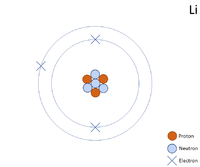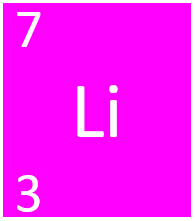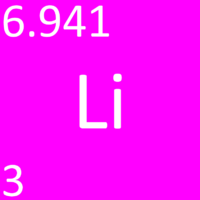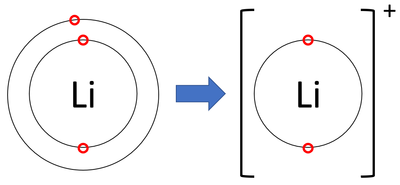Difference between revisions of "Lithium"
| (15 intermediate revisions by the same user not shown) | |||
| Line 3: | Line 3: | ||
[[Lithium]] is a [[metal]]. | [[Lithium]] is a [[metal]]. | ||
==Key Stage 3== | ==Key Stage 3== | ||
| + | [[File:LithiumSymbol1.png|right|300px|thumb|The [[Chemical Symbol|chemical symbol]] for [[Lithium]].]] | ||
| + | [[File:Li-7_WK.PNG|right|200px|thumb|A 2 dimensional representation of a [[Lithium]] [[atom]] with 3 [[proton]]s and 4 [[neutron]]s in the [[Atomic Nucleus|nucleus]] and 3 [[electron]]s orbiting the [[Atomic Nucleus|nucleus]].]] | ||
===Meaning=== | ===Meaning=== | ||
| − | + | [[Lithium]] is a [[Group 1]] [[element]], on the [[Periodic Table]], with an [[Atomic Number|atomic number]] of 3. | |
| − | [[Lithium]] is a [[Group 1]] [[element]] with an [[Atomic Number|atomic number]] of 3. | ||
===About Lithium=== | ===About Lithium=== | ||
| − | : [[Lithium]] has the [[Chemical | + | ====Molecular Structure==== |
| + | : [[Lithium]] has the [[Chemical Symbol|chemical symbol]] [[Lithium|Li]]. | ||
| + | : [[Lithium]] [[atom]]s join together in large numbers to form a giant [[metal]] [[molecule]]. | ||
| + | ====Atomic Structure==== | ||
: [[Lithium]] has 3 [[proton]]s and 4 [[neutron]]s in its [[Atomic Nucleus|nucleus]] giving it an [[Atomic Number]] of 3 and an [[Relative Atomic Mass|atomic mass]] of 7. | : [[Lithium]] has 3 [[proton]]s and 4 [[neutron]]s in its [[Atomic Nucleus|nucleus]] giving it an [[Atomic Number]] of 3 and an [[Relative Atomic Mass|atomic mass]] of 7. | ||
| + | : An [[atom]] of [[Lithium]] has only 1 [[electron]] in its [[Outer Shell|outer shell]]. | ||
| + | ====Properties==== | ||
: [[Lithium]] is the least [[Reactivity|reactive]] [[Alkali Metal]]. | : [[Lithium]] is the least [[Reactivity|reactive]] [[Alkali Metal]]. | ||
: [[Lithium]] is more [[Reactivity|reactive]] than [[Carbon]] on the [[Reactivity Series|reactivity series]] so it must be [[Extraction of Metals|extracted]] from its [[ore]] using [[electrolysis]]. | : [[Lithium]] is more [[Reactivity|reactive]] than [[Carbon]] on the [[Reactivity Series|reactivity series]] so it must be [[Extraction of Metals|extracted]] from its [[ore]] using [[electrolysis]]. | ||
| + | : [[Lithium]] [[Oxidation|oxidises]] quickly in the presence of [[Oxygen]] so it must be stored in [[oil]]. | ||
: [[Lithium]] [[Chemical Reaction|reacts]] strongly with [[water]] to produce [[Hydrogen]] [[gas]] and [[Lithium Hydroxide]]. | : [[Lithium]] [[Chemical Reaction|reacts]] strongly with [[water]] to produce [[Hydrogen]] [[gas]] and [[Lithium Hydroxide]]. | ||
: [[Lithium]] is a [[solid]] at [[STP|room temperature]]. | : [[Lithium]] is a [[solid]] at [[STP|room temperature]]. | ||
| − | + | ||
| − | |||
==Key Stage 4== | ==Key Stage 4== | ||
| + | [[File:LiKS4.png|right|200px|thumb|The [[Chemical Symbol|chemical symbol]] for [[Lithium]].]] | ||
| + | [[File:Li-7_WK.PNG|right|200px|thumb|A 2 dimensional representation of the [[Bohr Model]] of a [[Lithium]]-7 [[isotope]] with 3 [[proton]]s and 4 [[neutron]]s in the [[Atomic Nucleus|nucleus]] and 2 [[electron]]s in the first [[Electron Orbital|shell]] and 1 in the [[Outer Shell|outer shell]].]] | ||
===Meaning=== | ===Meaning=== | ||
| − | [[Lithium]] is a [[Group 1]] [[element]] with 3 [[proton]]s in the [[Atomic Nucleus|nucleus]]. | + | [[Lithium]] is a [[Group 1]] [[element]], on the [[Periodic Table]], with 3 [[proton]]s in the [[Atomic Nucleus|nucleus]]. |
===About Lithium=== | ===About Lithium=== | ||
| − | : [[Lithium]] has the [[Chemical | + | ====Molecular Structure==== |
| + | : [[Lithium]] has the [[Chemical Symbol|chemical symbol]] [[Lithium|Li]]. | ||
| + | : [[Lithium]] [[atom]]s join together in a [[Giant Metallic Structure|giant metallic structure]]. | ||
| + | ====Atomic Structure==== | ||
: The most [[Stable Isotope|stable isotope]] of [[Lithium]] has 4 [[neutron]]s in its [[Atomic Nucleus|nucleus]] giving it an [[Relative Atomic Mass|atomic mass]] of 7. | : The most [[Stable Isotope|stable isotope]] of [[Lithium]] has 4 [[neutron]]s in its [[Atomic Nucleus|nucleus]] giving it an [[Relative Atomic Mass|atomic mass]] of 7. | ||
| + | : An [[atom]] of [[Lithium]] has only 1 [[electron]] in its [[Outer Shell|outer shell]]. | ||
| + | : [[Lithium]] [[ion]]s have lost an [[electron]] to become [[Positive Charge|positively charged]]. | ||
| + | {| class="wikitable" | ||
| + | |- | ||
| + | |[[File:LithiumIonFormation.png|center|400px]] | ||
| + | |- | ||
| + | | style="height:20px; width:200px; text-align:center;" |A [[diagram]] showing the formation of a [[Lithium]] [[ion]]. | ||
| + | |} | ||
| + | |||
| + | ====Properties==== | ||
: [[Lithium]] is the least [[Reactivity|reactive]] [[Alkali Metal]]. | : [[Lithium]] is the least [[Reactivity|reactive]] [[Alkali Metal]]. | ||
: [[Lithium]] is more [[Reactivity|reactive]] than [[Carbon]] on the [[Reactivity Series|reactivity series]] so it must be [[Extraction of Metals|extracted]] from its [[ore]] using [[electrolysis]]. | : [[Lithium]] is more [[Reactivity|reactive]] than [[Carbon]] on the [[Reactivity Series|reactivity series]] so it must be [[Extraction of Metals|extracted]] from its [[ore]] using [[electrolysis]]. | ||
| + | : [[Lithium]] [[Oxidation|oxidises]] quickly in the presence of [[Oxygen]] so it must be stored in [[oil]]. | ||
: [[Lithium]] [[Chemical Reaction|reacts]] strongly with [[water]] to produce [[Hydrogen]] [[gas]] and [[Lithium Hydroxide]]. | : [[Lithium]] [[Chemical Reaction|reacts]] strongly with [[water]] to produce [[Hydrogen]] [[gas]] and [[Lithium Hydroxide]]. | ||
: [[Lithium]] is a [[solid]] at [[STP|standard temperature and pressure]] with a [[Melting Point|melting point]] of 180.50 [[Degrees Celsius|°C]]. | : [[Lithium]] is a [[solid]] at [[STP|standard temperature and pressure]] with a [[Melting Point|melting point]] of 180.50 [[Degrees Celsius|°C]]. | ||
| − | : | + | |
| − | + | ==Beyond the Curriculum== | |
| + | {{#ev:youtube|https://www.youtube.com/watch?v=byGE-bhNzOY}} | ||
Latest revision as of 13:51, 19 February 2021
Contents
Key Stage 2
Meaning
Key Stage 3
Meaning
Lithium is a Group 1 element, on the Periodic Table, with an atomic number of 3.
About Lithium
Molecular Structure
- Lithium has the chemical symbol Li.
- Lithium atoms join together in large numbers to form a giant metal molecule.
Atomic Structure
- Lithium has 3 protons and 4 neutrons in its nucleus giving it an Atomic Number of 3 and an atomic mass of 7.
- An atom of Lithium has only 1 electron in its outer shell.
Properties
- Lithium is the least reactive Alkali Metal.
- Lithium is more reactive than Carbon on the reactivity series so it must be extracted from its ore using electrolysis.
- Lithium oxidises quickly in the presence of Oxygen so it must be stored in oil.
- Lithium reacts strongly with water to produce Hydrogen gas and Lithium Hydroxide.
- Lithium is a solid at room temperature.
Key Stage 4

A 2 dimensional representation of the Bohr Model of a Lithium-7 isotope with 3 protons and 4 neutrons in the nucleus and 2 electrons in the first shell and 1 in the outer shell.
Meaning
Lithium is a Group 1 element, on the Periodic Table, with 3 protons in the nucleus.
About Lithium
Molecular Structure
- Lithium has the chemical symbol Li.
- Lithium atoms join together in a giant metallic structure.
Atomic Structure
- The most stable isotope of Lithium has 4 neutrons in its nucleus giving it an atomic mass of 7.
- An atom of Lithium has only 1 electron in its outer shell.
- Lithium ions have lost an electron to become positively charged.
| A diagram showing the formation of a Lithium ion. |
Properties
- Lithium is the least reactive Alkali Metal.
- Lithium is more reactive than Carbon on the reactivity series so it must be extracted from its ore using electrolysis.
- Lithium oxidises quickly in the presence of Oxygen so it must be stored in oil.
- Lithium reacts strongly with water to produce Hydrogen gas and Lithium Hydroxide.
- Lithium is a solid at standard temperature and pressure with a melting point of 180.50 °C.


